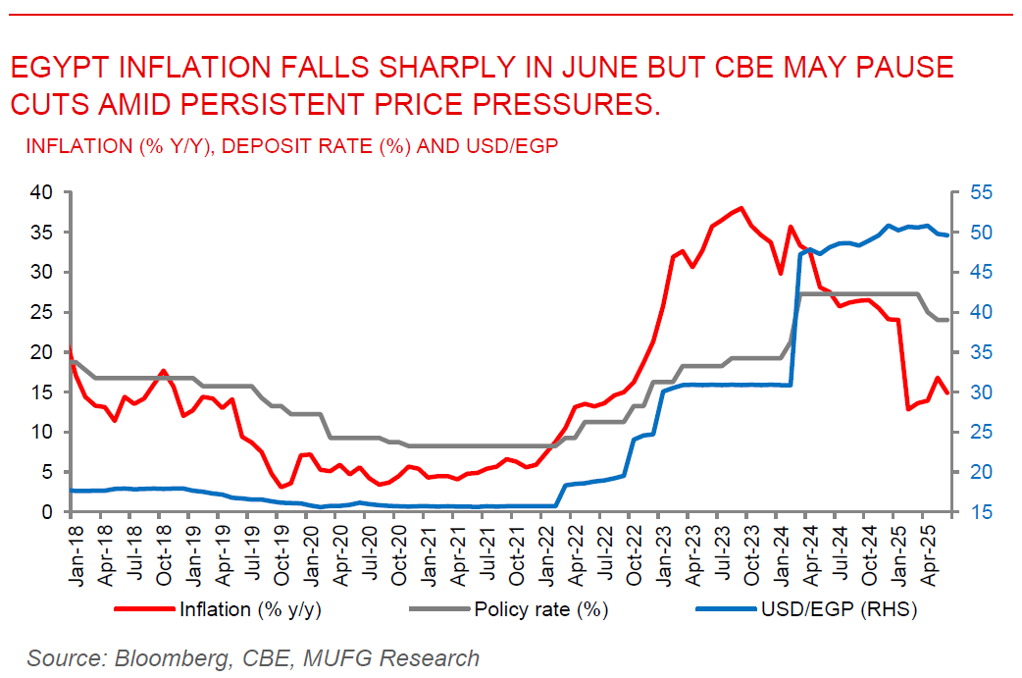To read the full report, please download the PDF above.
Middle East Daily
SOOJIN KIM
Research Analyst
DIFC Branch – Dubai
T: +44(4)387 5031
E: soojin.kim@ae.mufg.jp
MUFG Bank, Ltd. and MUFG Securities plc
A member of MUFG, a global financial group
Middle East Daily
COMMODITIES / ENERGY
Oil holds steady amid US stockpile surge and escalating trade tensions. Oil prices steadied on 10 July as traders balanced a sharp 7.1mb build in US crude inventories, the largest since January, and growing global trade uncertainty triggered by President Trump’s wave of new tariffs. Brent hovered around USD70/b, while WTI was around USD68/b. Stockpiles at Cushing also rose for the first time since May. Despite OPEC+ agreeing to a larger than expected output hike for August, oil remains slightly higher this week as the group banks on strong summer demand to absorb the additional supply. However, concerns over a potential glut later this year persist. Meanwhile, tensions in the Middle East remain in focus after renewed Red Sea attacks by Iran-backed Houthi militants, adding a layer of geopolitical risk to the market.
Gold holds gains as Fed split and tariff uncertainty support safe haven demand. Gold held near USD3,318/oz after a modest rise, as investors digested the Fed’s divided stance on rate cuts and President Trump’s escalating trade tariff campaign. Fed minutes revealed a split among officials, with 10 out of 19 projecting at least two rate cuts in 2025, while others forecast none, creating uncertainty around the rate outlook. Meanwhile, Trump’s new wave of tariff letters, including steep levies on Brazil, added to market caution despite some easing in immediate trade fears. The ongoing tariff saga, along with subdued Treasury yields and geopolitical tensions, continues to fuel demand for gold, which has surges about 25% this year following a record high in April, central bank buying and haven flows remain key drivers.
MIDDLE EAST - CREDIT TRADING
End of day comment – 09 July 2025. Mixed and overall weaker day. Volumes are tracking below average this week and sellers again outnumbered buyers by nearly 2:1. The morning was a bit more constructive but even with the UST recovery in the evening we saw more and more sellers coming in during the day across bonds. Outperformers remain IG sovereign duration bonds. QATAR and ADGB had a strong bid in the morning in 49s/54s respectively which held in the afternoon but with higher UST closing wider +0.5pt/+1bp. Quasis had more afternoon selling and widened 3/5bp with ADNOCM and QPETRO seeing most activity. Higher betas had also a weaker day, MOROC seen long end selling mainly in 50s closing -0.125pt/+6bp. Fins were quiet, recent new QATIQD perps remains offered below reoffer and traded today mostly in a 99.75/875 range. In corps DPWDU had a belly bid (33s +0.125pt/+2bp) in the morning but saw long end sellers in the afternoon (49s unch/+4bp). The market continues to trade cautiously retracing from the spread tightening last week. As more tariff letters are getting sent out we await announcements on Europe as well as UST auctions and FED minutes. Technicals are turning to -ve, especially in the quasi sovereign sector.
MIDDLE EAST - MACRO / MARKETS
Egypt inflation falls sharply in June but CBE may pause cuts amid persistent price pressures. Egypt’s headline inflation fell sharply to 14.9% y/y in June from 16.8% y/y in May due to a seasonal drop in food prices. This marks the lowest monthly inflation print since May 2024 at -0.2%, though the decline is seen as transitory with inflation expected to rebound to 15.5-16% y/y in July due to recent tobacco tax hikes and a favourable base effect from July 2023. Despite the downside surprise, inflation remains elevated compared to April, 13.9%, and the CBE may hold rates steady at today’s meeting, though a 100bps cut cannot be ruled out given high real rates. Policymakers are expected to balance cautious rate easing against external pressures, including Suez Canal disruptions and an energy deficit, while still aiming for year-end inflation of 15% and a gradual disinflation path toward 10% by end-2026.
IMF warns of mounting risks as Iraq faces fiscal pressure and slowing growth. The IMF’s latest consultation highlights growing economic vulnerabilities in Iraq amid lower oil prices and financing constraints. Non-oil sector growth slowed sharply to 2.5% in 2024 from 13.8% in 2023, while inflation remains contained due to weak demand. Fiscal and external accounts are projected to deteriorate without urgent reforms. Iraq’s oil breakeven price rose to USD84 in 2024 from USD54 in 2020, raising debt stress concerns. The IMF urges a multiyear fiscal adjustment of 1-1.5% of non-oil GDP annually, improved tax and spending policies, and structural reforms to boost non-oil revenue and growth potential. The IMF also called for accelerated banking sector restructuring, monetary tightening, and better data transparency. With Iraq’s current growth model under pressures, the Fund stressed that reforms are critical to fiscal sustainability and long-term economic stability.

